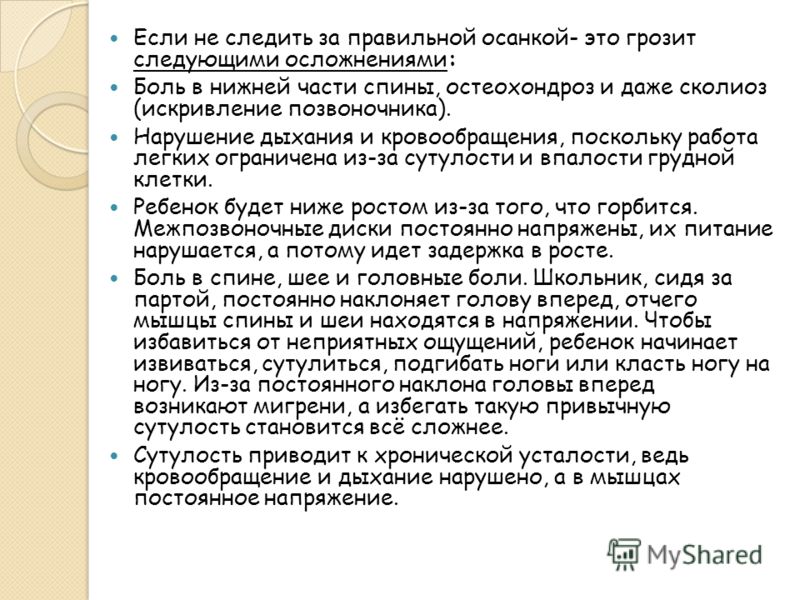Stevia - what is it, benefit and harm, application
stevia- bushy grass from the Astrov family. Grows naturally in Latin America. The plant is grown on plantations in order to obtain sweet substances that replace traditional sugar. Stevia raw materials and preparations have a low energy value and do not contain a glucose group. Therefore, with regular use, they do not increase blood sugar levels. Recommended for use in diabetes and those who want to get rid of excess weight. 50-300 times sweeter than sugar. Does not harm health. Plant extracts are distinguished by good culinary qualities, they are used in the food industry and at home, for baking and confectionery. It is known that stevia is unpretentious, can be grown at home. Regular use of honey grass strengthens the body and improves tone. For health, it is the #1 sweetener in the world!
Stevia - what is it?
Stevia is only called an herb. In fact, it is a perennial shrub. Its height reaches 120 cm. The accepted classification refers the Stevia genus to the numerous Astrov family, the Astroflower order, and the Dicotyledon class.
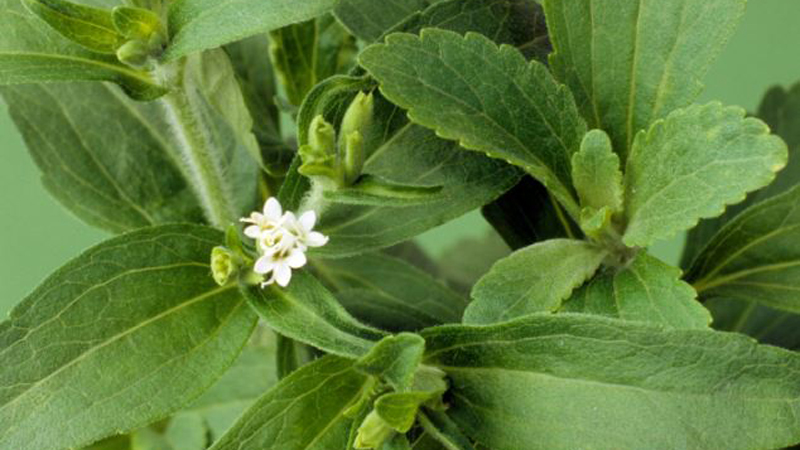
Rice. 1. Stevia plant inflorescences
Stevia has a stem up to 1.5 cm thick. The bush is well pubescent, its shape is different, depending on the place of growth and the method of cultivation. Paired leaves, saturated green, have rounded serrated edges. During the flowering period, stevia is covered with small white, sometimes with a pinkish tinge, inflorescences (Fig. 1). Ripe seeds are small, brownish or grayish in color.
The Stevia genus includes 241 species, but only one of them - Stevia rebaudiana Bertoni or honey stevia - is grown and processed on an industrial scale. Only the leaves of the shrub go into processing, they are harvested immediately before flowering, when the concentration of sweet substances is highest.
Where does it grow?
Stevia comes from Latin America. Stevia prefers light soils with low salinity, semi-arid climates and plenty of sun. The natural habitat is the elevated plateaus and foothills of the South American continent. The largest amount of wild stevia is found in Paraguay. The same countries grow raw materials on plantations that are considered the best in quality (Fig. 2).
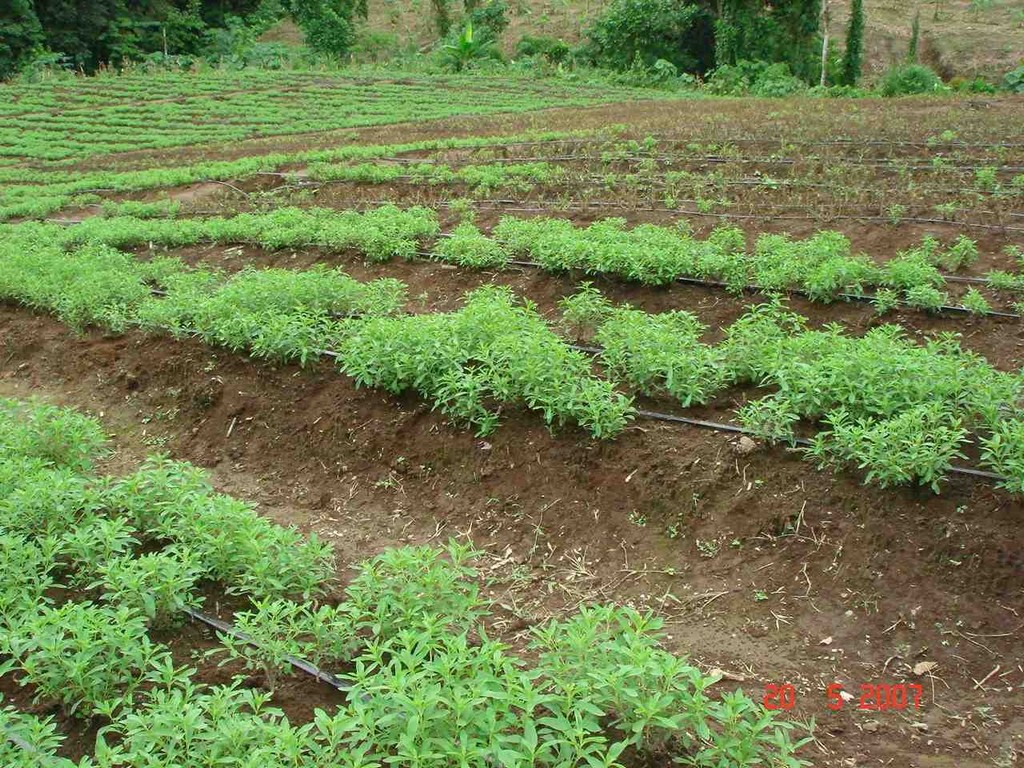
Rice. 2. Honey bush plantation in Brazil
Stevia has taken root well in Southeast Asia. Since the 90s of the last century, it has been actively cultivated in many countries of this region. Today, the main supplier of stevia to the world market is China.
The chemical composition of stevia
The leaves of this shrub contain many useful elements.
Tab. 1. Stevia. Chemical composition
|
Components |
|
|
Plant polyphenols (flavonoids) |
|
|
Green and yellow pigment |
|
|
Glycosides |
|
|
free sugars |
|
|
Hydroxycinnamic acids |
|
|
Amino acids |
|
|
Trace elements (zinc, potassium, magnesium, iodine, selenium, etc.) |
|
|
B vitamins, also A, C, D, E, K, P |
Stevia is sweetened by glycosides (https://ru.wikipedia.org/wiki/Glycosides). Organic origin, belong to the class of essential sugars. Included in many plants. Usually the highest concentration is reached in flowers and leaves. The main difference from conventional refined sugar lies in the fact that these organic compounds do not have a glucose group in their chemical structure. As a result - The use of stevia does not lead to a sharp increase in blood glucose.
Essential sugars make up an extensive group of substances with different characteristics. Some compounds are extremely bitter, while others are very sweet. Stevia leaves accumulate 11 types of glycosides, which have a sweet taste, but with a bitter note. This is why fresh and dried leaves have a bitter, licorice flavor. The dry and liquid extracts obtained as a result of deep processing are spared from this disadvantage. Since they fully correspond to the taste of ordinary refined sugar, and do not harm the body.
Each of the 11 glycosides received its own name.
Tab. 2. Stevia: characteristics of glycosides
|
Glycoside |
Sweetness (so many times the glycoside is sweeter than regular sugar) |
|
|
Stevioside |
||
|
Rebaudoside A |
||
|
Rebaudoside B |
||
|
Rebaudoside C |
||
|
Rebaudoside D |
||
|
Rebaudoside E |
||
|
Rebaudoside F |
No data |
|
|
rubusoside |
||
|
Stviolmonoside |
No data |
|
|
Steviolbioside H |
||
|
Steviolbioside b - Gic |
Glycosides are united by a common industrial name - " Steviol". The table shows that the bulk of essential sugars are stevioside and rebaudoside A. These components are the basis for the production of dry concentrated extracts.
honey grass calories
Its leaves are low in calories. Of course, fiber and other carbohydrate elements have energy value. However, sweet components - steviols - are characterized strong chemical bond sugar and carbohydrate (non-sugar) groups. Therefore, in the digestive system, the breakdown of this bond occurs very slowly. In addition, essential sugars and sucrose have a different nature. Unlike sucrose, steviol in the process of assimilation does not form the main source of energy - glucose. As a result, the calorie content of "honey grass" is only 18 kcal per 100 g.
Products of deep processing of raw materials consist of almost pure glycosides. Therefore, their calorie content can be ignored.
Release forms
Manufacturers offer stevia in a different state of aggregation, and with varying degrees of processing. First of all, it is dried leaves (Fig. 3) and powder from it. Then, extracts and concentrates of the bush. Stevia is used as the main sweetener in a range of foods or is available separately.

Rice. 3. Dried Sweetener Leaves
Dry
We mean, first of all, products of deep processing of raw materials. These are crystalline, powdery substances with a high percentage of steviol. Consisting of 97% Rebaudoside A, REB 97A Stevia Powder is considered the purest dry extract. Because of their extreme sweetness, they find their main use in the production of mass products.
Often used in a mixture with other sweeteners - sucralose, sorbitol, fructose. This allows you to maintain the usual dosage and, at the same time, reduce calorie content.
Liquid
Steviols are highly soluble in water. This allows you to achieve the desired sweetness of the solution. To do this, it is enough to mix the active substance with the liquid in the desired proportion. Here, too, mixtures with other sweeteners are in use. easy to pack and practical to use.
Extract in tablets
The difference between tablets with an extract (Fig. 4) and their medicinal "brothers" is that they should not be swallowed and washed down with water, but, on the contrary, thrown into a hot drink, and then drink the liquid. This form of release of the drug is convenient for selecting an individual dose. This feature is especially useful for people with diabetes.
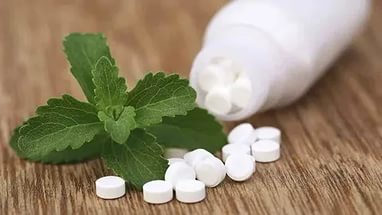
Rice. 4. Stevia tablets
Stevia - benefits and harms. What are the contraindications?
The benefits and harms of honey grass for human health have been studied extremely deeply. Laboratory studies and practice of use show that for most people stevia is absolutely safe. At the same time, the ill-conceived use of a herbal preparation can cause an unpleasant reaction. Here are the cases in which stevia can cause damage to health:
- there is always the possibility of individual intolerance to the drug; if you feel unwell, immediately stop taking and consult a doctor;
- excessive overdose, in some cases, leads to nausea and even vomiting;
- combining with dairy products (causes diarrhea);
- if a person suffers from a blood disease, hormonal disorders or a mental disorder, the reception is possible strictly according to the doctor's prescription;
- diabetic patients should necessarily consult with an endocrinologist regarding the admissibility of taking the drug;
- blood pressure may decrease, hypotensive patients should take this into account;
- although very rare, allergic reactions do occur.
Do you know that...?
Until recently, stevia was suspected of being mutagenic and causing cancer. Only the intervention of the World Health Organization, which initiated additional thorough research, allowed the charges against the sweet bush to be dropped. Proven to be completely safe Stevia. As for neoplasms, it turned out that stevioside, on the contrary, block the development of cancer cells.
In general, it has been proven that even a significant overdose does not lead to serious consequences.
What are the benefits of stevia? Medicinal and beneficial properties
The list of positive qualities is so extensive and diverse that it will be more convenient to divide useful properties into thematic groups.
Nutritional Benefits
- Pleasant sweet taste. Despite the bitter taste, many people like tea brewed with stevia leaves. It is enough to throw a couple of leaves into a glass of boiling water, so that in a minute you get a pleasant, tasty drink. On sale, most often, there are dry leaves of a shrub or their extract. You can make tea leaves from this and add it to hot water or put a teaspoon of powder directly into a glass. Not everyone likes particles floating on the surface. In this case, you can use paper bags (sachets) with powder.
- High temperature resistance. Raw materials and plant preparations have excellent temperature characteristics. Stevia does not lose its inherent properties when heated to 200 0 C. This allows you to add liquid or dry extracts to hot drinks, pastries, confectionery.
- A good preservative. The herb is increasingly being used in home and industrial canning. It has bactericidal properties. This has been scientifically proven. Replacing sucrose in spins and canned food reduces the risk of product spoilage by mold and other biological pests.
- Long shelf life. Raw materials and preparations are stored for up to 10 years without any changes in quality. Low consumption allows you to make room for other products.
Preventive and curative benefits
The healing properties of the miracle shrub were noted even by the Indians of Latin America. Such treatment was popular: chewing the leaves to clean the mouth and strengthen the enamel of the teeth, use the infusion of the plant to disinfect and speed up the healing process of scratches and wounds.
Do you know that...?
In Paraguay, residents consume, on average, 10 kg of sweet grass leaves per year. The country has one of the lowest rates of diabetes, with a low percentage of obese people. Since the leaves of stevia contain all the healing properties necessary for the body.
It is necessary to emphasize the positive effects that are manifested due to the two main qualities of the plant extract - low calorie content and the inability to significantly affect blood sugar. Stevia is good for:
Stevia on the market is diverse and has varying degrees of sweetness. An inexperienced person can easily get confused about the dosage. To prevent this from happening, the table shows the proportional correspondence of stevia preparations to the sugar equivalent.
Tab. 3. The ratio of dosages of stevia and regular sugar
|
regular sugar |
Stevioside |
liquid extract |
|
|
1 teaspoon |
On the tip of a knife |
2 - 6 drops |
1/4 teaspoon |
|
1 tablespoon |
On the tip of a knife |
1/8 teaspoon |
3/4 teaspoon |
|
1/2 - 1/3 teaspoon |
1/2 teaspoon |
2 tablespoons |
Honey grass for diet and weight loss
Stevia, whose benefits for digestion are undeniable, is included in special diets. A special diet is prescribed in the treatment of certain diseases, such as diabetes. All ingredients included in the dietary menu pursue a single therapeutic goal. The role of the sweetener is to reduce the total calorie content of the diet and stabilize blood sugar levels.
The extract fits well into the list of products that help to lose weight. Those who want to lose weight should give up sweets, which is not for everyone. Sweet grass compensates for this need. At the same time, it contains many useful elements and a minimum of calories. Its action improves the general condition and does not affect weight.
Another important advantage is that stevioside preparations do not provoke an increase in appetite. Studies have shown that stevia is just as satiating as sugary foods.
Do you know that...?
Stevia is easy to grow at home, on the windowsill. To do this, you must observe the temperature regime - not lower than 15 0 C, place the pot on the south side and water regularly. The shrub does not sprout well from seeds, it is better to take seedlings.
Stevia benefits for diabetes
Stevia helps to solve a number of problems that inevitably arise before every diabetic.
- Patients with diabetes experience discomfort from the ban on sweets. Stevia fills this gap in taste. It is 50-300 times sweeter than sugar. Diabetics can use the plant to sweeten drinks and foods without the risk of spikes in blood sugar levels.
- In addition to the usual products - leaves, powders, liquid and dry extracts - the market offers a wide range of products where refined sugar is replaced by stevia. Low-calorie bars, confectionery, pastries, drinks allow patients to lead their usual way of life, not to feel deprived of something.
- The problem of weight loss is solved. Complete rejection of refined sugar greatly reduces the total caloric content of the diet, contributes to the normalization of body weight. Sweetener does not increase appetite. Thus, the problem of bouts of hunger is removed.
- The microcirculation of blood vessels improves, which relieves cramps in the limbs. The most important thing is that stevia normalizes the level of glucose in the body, and even contributes to its decrease.
honey herb during pregnancy
Doctors do not prohibit taking stevia during pregnancy. During this period, women's sugar levels rise. This worries many, as it is accompanied by dry mouth, increased pressure and appetite. Honey grass will help normalize blood pressure in pregnant women and relieve unpleasant symptoms.
Special studies on the effects of plant preparations on the health of pregnant women have not been conducted. But it is known for certain that stevia does not adversely affect the development of the fetus.
Can children take stevioside?
Pediatricians have no complaints about stevia, and nutritionists recommend including it in children's diets. In the children's menu, replacing refined sugar with “honey grass” provides a number of advantages:
- this is an excellent prevention of diabetes, the child's pancreas is freed from excessive sugar load;
- low calorie content helps to maintain normal weight;
- honey grass protects against such a sugar misfortune as caries, on the contrary, it strengthens tooth enamel;
- stevia extracts for the body (unlike regular sugar) are not addictive, babies do not require more and more sweets;
- cases of allergy to stevia are extremely rare.
Stevia in cooking
The sweet components of the herb have a high chemical stability. They do not break down at high temperatures. If we add to this good solubility in liquids, then the conclusion follows - stevia can completely replace refined sugar in cooking. Here are some recipes:
Tea
Dry leaves or Stevia powder - 1 teaspoon - pour boiling water and leave for 20-30 minutes. You can drink. If the drink is cold, reheat in the microwave. It is more practical to make a concentrated leaf tea in a small teapot, and then add it to a glass or mug of boiling water as needed. Tea (Fig. 5) has a slightly unusual, but pleasant taste.
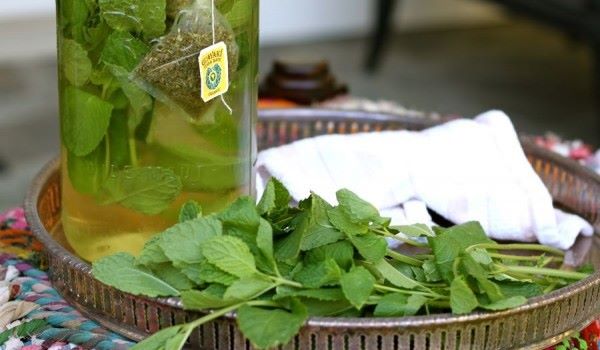
Rice. 5. Tea with stevia
Bakery products
Cookies
- We take: a teaspoon of liquid extract, 1 egg, two glasses of flour, half a glass of milk, 50 g of butter, salt, soda;
- Add the ingredients to one container and knead the dough;
- Roll out the mass to the desired thickness and cut into shape;
- We put in the oven, temperature 200 0 C, until cooked.
Cookie
- You will need: flour - 2 cups; water - 1 glass; butter - 250 g; stevioside - 4 tablespoons; 1 egg; salt;
- We knead the dough;
- We roll out the dough, form cookies and send it to the oven, heated to 200 0 C.
Jam and compotes
Strawberry compote
- take a liter jar and pour washed strawberries into it, to the top;
- prepare a solution; in 250 ml of water add 5 tbsp. spoons of stevia infusion; boil;
- pour strawberries with hot solution and pasteurize for 10 minutes.
Preparation of infusion and syrup from honey grass
Infusion. We put leaves in a gauze bag - 100 g. Place it in a container and pour half a liter of boiling water into it. We endure the day. Drain the resulting liquid into a separate bowl. Add another half-liter of water to the leaves and boil again for 50 minutes. Mix both liquids and filter from the leaves. The resulting infusion can be added to any dishes. It improves health well.
Syrup. It is necessary to take the infusion and evaporate it in a water bath until it acquires a viscous consistency. Readiness can be determined by the degree of spreading of a drop of liquid on a solid surface.
The syrup is added to hot or soft drinks and confectionery.
- The latest methods of teaching traffic rules
- How to draw pictures by numbers
- Do-it-yourself home digital microscope
- How to choose the right paint for drawing
- When is the best time to sunbathe?
- What kind of bird is better to have in an apartment?
- We put an apostille on the birth certificate on our own
- Is it possible to give flowers in pots - signs
- How to make cat ears
- Gray bag: what to wear and combine?
- How to get started with Faberlic: tips for new consultants
- Bioinsecticide Lepidocid: purpose, properties and application procedure Lepidocide waiting period
- How to change the language to Russian in steam
- Dendrobium noble: room care
- Morphology of plants general concepts - document
- Planting, propagation and care of bamboo at home, photo Growing bamboo from seeds
- How to strengthen the cellular signal for the Internet in the country
- Sanskrit reveals the forgotten meaning of Russian words (2 photos)
- The oldest language Sanskrit programming language of the future Dead language Sanskrit
- Who has dominion over all the earth?



